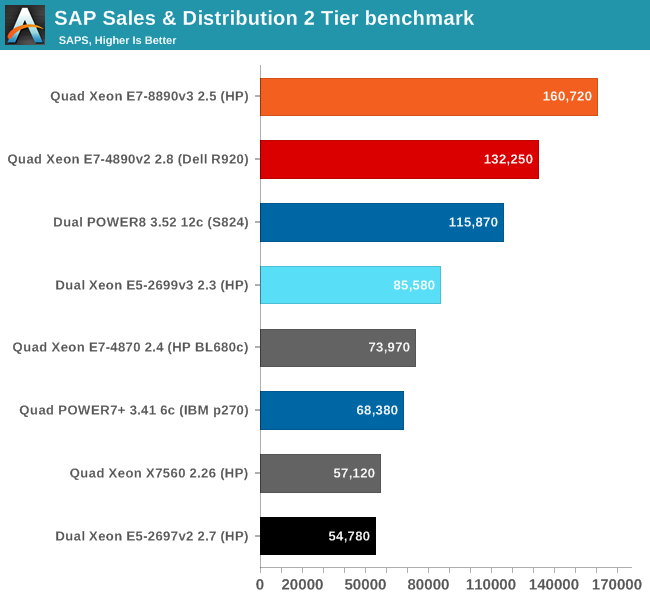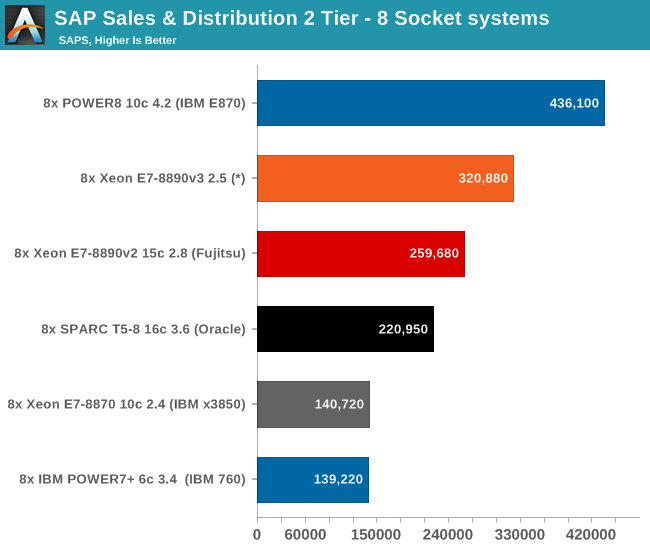The Intel Xeon E7-8800 v3 Review: The POWER8 Killer?
by Johan De Gelas on May 8, 2015 8:00 AM EST- Posted in
- CPUs
- IT Computing
- Intel
- Xeon
- Haswell
- Enterprise
- server
- Enterprise CPUs
- POWER
- POWER8
SAP S&D Benchmark
The SAP SD (Sales and Distribution, 2-Tier Internet Configuration) benchmark is an interesting benchmark as it is a real-world client-server application. It is one of those rare industry benchmarks that actually means something to the real IT professionals. Even better, the SAP ERP software is a prime example of where these Xeon E7 v2 chips will be used. We looked at SAP's benchmark database for these results.
Most of the results below all run on Windows 2008/2012 and MS SQL Server (both 64-bit). Every 2-Tier Sales & Distribution benchmark was performed with SAP's latest ERP 6 Enhancement Package 4. We analyzed the SAP Benchmark in-depth in one of our earlier articles. The profile of the benchmark has remained the same:
- Very parallel resulting in excellent scaling
- Low to medium IPC, mostly due to "branchy" code
- Somewhat limited by memory bandwidth
- Likes large caches (memory latency)
- Very sensitive to sync ("cache coherency") latency
Let's see how the quad Xeon compares to the previous Intel generation, the cheaper dual socket systems, and the RISC competition.

When we said that the competition in the high-end market was heating up, we were not kidding. The dual socket (24-core) S824 beats the dual socket Xeon E5 by a large margin (+35%), despite the latter having 50% more cores (36 vs 24).
At IBM's website, this server is priced at $65k, but the actual street prices are around $35k, slightly below what a typical similar quad Xeon costs (around $40k) .Of course, IBM should make it easier for small enterprises to get their hardware quickly at a decent price. But this shows that it is not impossible that POWER servers can become an alternative to the typical x86 systems... just not from IBM's webstore. The POWER8 system might be somewhat cheaper to acquire than the HP DL580 Gen9, but that Intel system is still almost 40% faster, so IBM is not an alternative quite yet. Then again, IBM is a lot more competitive than a few years ago. The S824 is not that far behind the Quad Xeon E7 v2, so it is a good thing that the new Xeon E7 offers about 20% better performance than the latter.
So who is on the top of server foodchain?

They might be power hungry, but the new POWER8 has made the Enterprise line of IBM more competitive than ever. Gone are the days that IBM needed more CPU sockets than Intel to get the top spot. Nevertheless, it should be noted that you can get several 8-socket Xeon systems for the price of one IBM E870 enterprise server.










146 Comments
View All Comments
Dmcq - Saturday, May 9, 2015 - link
Well they'll sell where performance is an absolute must but they won't pose a problem to Intel as they won't take a large part of the market and they'd keep prices high. I see the main danger to Intel being in 64 bit ARMs eating the server market from below. I suppose one could have cheap and low power POWER machines to attack the main market but somehow it just seems unlikely with their background.Guest8 - Saturday, May 9, 2015 - link
Uh did you see Anandtech's reviews on the latest ARM server? The thing barely keeps up with an Avoton. Intel is well aware of ARM based servers and has preemptively disARMed the threat. If ARM could ever deliver Xeon class performance it would look like Power8.melgross - Saturday, May 9, 2015 - link
Chip TDP is mostly a concern for the chip itself. Other areas contribute far more waste heat than the CPU does.PowerTrumps - Saturday, May 9, 2015 - link
Power doesn't need to have a TDP of 1000W but 200W is nothing given the performance and efficiency advantage of the processors and Power hypervisor. When you can consolidate 2, 4 and 10 2 socket Intel servers into 1 x 2 socket Power8 server that is 10 x 2 x 135W = 2700 overall Watts vs 400W with the Power server. Power reduces the overall energy, cooling and rack space consumption.KAlmquist - Saturday, May 9, 2015 - link
$4115 E5-2699 (18C, 2.3 Ghz (3.6 Ghz turbo), max memory 768 GB)$5896 E7-8880 (18C, 2.3 Ghz (3.1 Ghz turbo), max memory 1536 GB)
That's a big premium for the E7--enough that it probably doesn't make sense to buy an 8 socket system just to run a bunch of applications in parallel. The E7 makes sense only if you need more than 36 cores to have access to the same memory.
PowerTrumps - Saturday, May 9, 2015 - link
I really enjoyed the article as well as the many data and comparison charts. It is unfortunate that most of your statements, assessments and comparisons about Power and with Intel to Power were either wrong, misleading, not fully explained or out of context. I invite the author to contact me and I will be happy to walk you through all of this so you can update this article as well as consider a future article that shows the true advantage Power8 and OpenPower truly has in the data center and the greater value available to customers.KAlmquist - Saturday, May 9, 2015 - link
I would be surprised if anybody working for Anandtech is going to contact an anonymous commentator. You can point out portions of the article that you think are wrong or misleading in this comment section.To do a really good article on Power8, Anandtech needs a vendor to give Anandtech access to a system to review.
PowerTrumps - Sunday, May 10, 2015 - link
Admittedly I assumed when I registered for the PowerTrumps account some time ago I used a email address which they could look up. But, your point is taken. Brett Murphy with Software Information Systems (aka SIS) www.thinksis.com. Email at bmurphy@thinksis.com. If I pointed out all of the mistakes my comment would look like a blog which many don't appreciate. I have my own blog for that. I like well written articles and happy to accept criticism or shortcomings with IBM Power - just use accurate data and not misrepresent anything. Before Anandtech reviews a Power8 server, my assessment is they need to understand what makes Power tick and how it is different than Intel or SPARC for that matter. Hope they contact me.thunng8 - Sunday, May 10, 2015 - link
I too would like a more detailed review of the Power8.Some of the text in the article made me laugh on how wrong they are.
For example, the great surprise that Intel is not on top.. Well anandtech has never test any Power systems before..
And it is laughable to make any conclusions based on running of 7zip. Just about any serious enterprise server benchmark shows a greater than 2x performance advantage per core in favor of Power compared to the best Xeons. So that 50% advantage is way less than expected.
Btw Power7 for most of its life bested Xeon in performance by very large margins. It is just now that IBM have opened up Power to other vendor that makes it exciting.
JohanAnandtech - Monday, May 11, 2015 - link
I welcome constructive critism. And yes, we only had access to an IBM Power8 dev machine, so we only got a small part of the machine (1 core/2GB)."Some of the text in the article made me laugh on how wrong they are."
That is pretty low. Without any pointer or argument, nobody can check your claims. Please state your concerns or mail me.